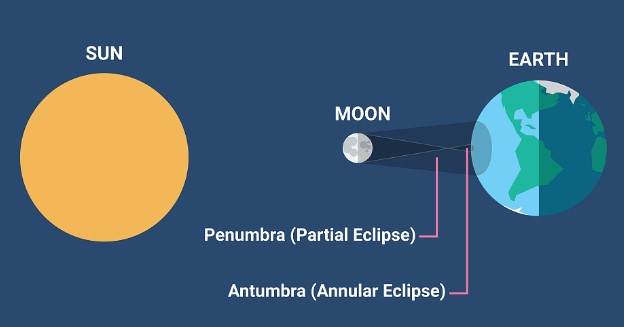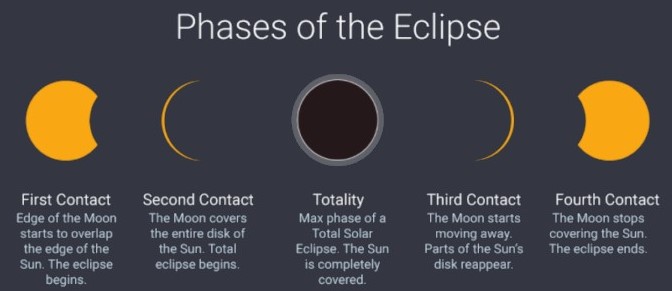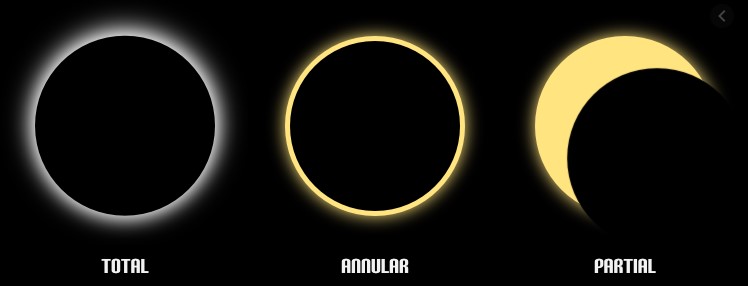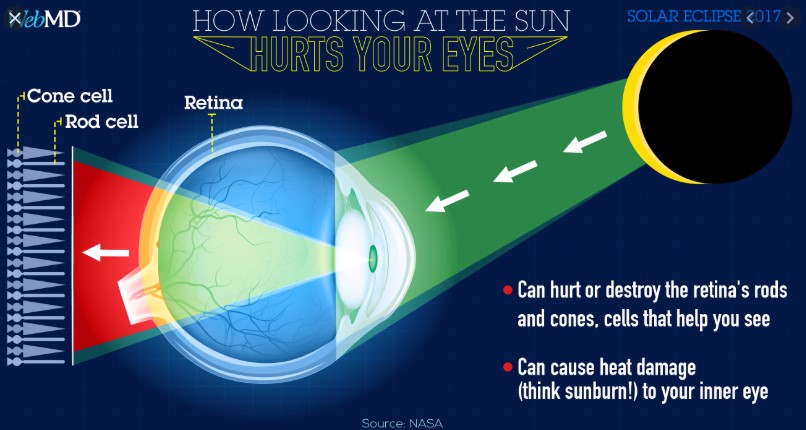Contents
- Annular Eclipse of the Sun- 21st June
ANNULAR ECLIPSE OF THE SUN- 21 JUNE
Focus: GS-I Geography
Why in news?
An annular solar eclipse will occur on 21st June, 2020 and it will be visible in India within a narrow corridor of northern part of the country.
The annular path passes through Congo, Sudan, Ethiopia, Yemen, Saudi Arabia, Oman, Pakistan, northern parts of India and China.
Solar eclipse
- A solar eclipse occurs when a portion of the Earth is covered in a shadow cast by the Moon which fully or partially blocks sunlight.
- This occurs when the Sun, Moon and Earth are aligned.
- Such alignment coincides with a new moon (syzygy) indicating the Moon is closest to the ecliptic plane.
- The Sun’s distance from Earth is about 400 times the Moon’s distance, and the Sun’s diameter is about 400 times the Moon’s diameter. Because these ratios are approximately the same, the Sun and the Moon as seen from Earth appear to be approximately the same size: about 0.5 degree of arc in angular measure.


Types of Solar Eclipses
- In a total eclipse, the disk of the Sun is fully obscured by the Moon, allowing only the much fainter solar corona to be visible. (only outer ring is visible).
- In partial and annular eclipses, only part of the Sun is obscured.
- Even in Annular eclipse only an outer ring is visible, however apparent size of the moon is not large enough to block the Sun entirely, hence the ring is thinker exposing a portion of the Sun.
- Hybrid Eclipse: It is a rare phenomenon where the eclipse is annular for the first few seconds. For the rest it will be a total eclipse.

Why does the Solar Eclipse not occur during every new moon?
- If the Moon were in a perfectly circular orbit, a little closer to the Earth, and in the same orbital plane, there would be total solar eclipses every new moon.
- However, since the Moon’s orbit is tilted at more than 5 degrees to the Earth’s orbit around the Sun, its shadow usually misses Earth.
So, what are the factors that affect the frequency of Solar Eclipse?
- Special conditions must occur for the two events to coincide because the Moon’s orbit crosses the ecliptic at its orbital nodes twice every draconic month (approx. 27 days) while a new moon occurs one every synodic month (approx. 29 and a half days).
- The frequency of Solar eclipses (and even Lunar eclipses) is at least two, and up to five, solar eclipses each year; and up to two of these can be total eclipses.
- Total solar eclipses are rare at any particular location because totality exists only along a narrow path on the Earth’s surface traced by the Moon’s full shadow or umbra.
- During any one eclipse, totality occurs at best only in a narrow track on the surface of Earth. This narrow track is called the path of totality. Hence, it is rare at any particular location.
What are the factors that affect the duration of the eclipse?
- The Moon being almost exactly at perigee (making its angular diameter as large as possible).
- The Earth being very near aphelion (furthest away from the Sun in its elliptical orbit, making its angular diameter nearly as small as possible).
- The midpoint of the eclipse being very close to the Earth’s equator, where the rotational velocity is greatest.
- The vector of the eclipse path at the midpoint of the eclipse aligning with the vector of the Earth’s rotation (i.e. not diagonal but due east).
- The midpoint of the eclipse being near the subsolar point (the part of the Earth closest to the Sun).
Significant observations during solar eclipses
- A total solar eclipse provides a rare opportunity to observe the corona (the outer layer of the Sun’s atmosphere). Normally this is not visible because the photosphere is much brighter than the corona.
- Eclipses may cause the temperature to decrease by up to 3 °C.
- There is a long history of observations of gravity-related phenomena during solar eclipses, especially during the period of totality.
- Confirmation of Einstein’s theory: The observation of a total solar eclipse of 1919, helped to confirm Einstein’s theory of general relativity. By comparing the apparent distance between stars in the constellation Taurus, with and without the Sun between them, Arthur Eddington stated that the theoretical predictions about gravitational lenses were confirmed.
Precautions to take while viewing Solar eclipse
- Looking directly at the photosphere of the Sun (the bright disk of the Sun itself), even for just a few seconds, can cause permanent damage to the retina of the eye, because of the intense visible and invisible radiation that the photosphere emits.
- This damage can result in impairment of vision, up to and including blindness.
- The retina has no sensitivity to pain, and the effects of retinal damage may not appear for hours, so there is no warning that injury is occurring.
- Under normal conditions, the Sun is so bright that it is difficult to stare at it directly, however, during an eclipse, with so much of the Sun covered, it is easier and more tempting to stare at it.
- Special eye protection or indirect viewing techniques are used when viewing a solar eclipse.
- It is safe to view only the total phase of a total solar eclipse with the unaided eye and without protection.






